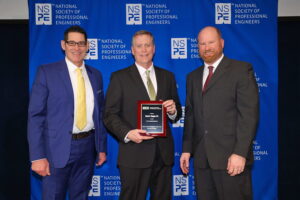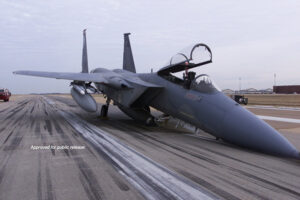A fully-loaded B-52H Stratofortress weighs nearly half-a-million pounds; getting one airborne is a feat of modern engineering, but getting it safely back on the ground may be an even more impressive accomplishment. In an instant, six stalks of steel and rubber must catch and balance the weight of 20 school buses, keeping everything upright while screeching to a stop from 200 mph.
A microscopic crack in any one of those pieces of landing gear could result in critical failure and a crash with more than a $100 million price tag, not to mention the catastrophic risk to anyone onboard.

That’s where Chad Hogan, member of the John and Marcia Price College of Engineering Alumni Association Board and Department of Mechanical Engineering Industrial Advisory Board, comes in.
A 1994 Mechanical Engineering alumnus and Lead Engineer at Hill Air Force Base, Hogan specializes in the unique mechanical and material properties of landing gear components. His research on new protective coatings that slows the degradation of high-strength steel earned Hogan a spot as a finalist for the Society of Professional Engineers Federal Engineer of the Year award.
And while he’s proud of his professional accolades, Hogan sees the real prize in the work itself. He estimates that his career efforts redesigning aircraft braking systems and landing gear structures have helped save the Air Force — and the American taxpayer — nearly $3 Billion in aggregate lifetime savings and an estimated 70% reduction in operational failures.
Statistically, a plane’s engines are the subsystem most at risk of failure, but only because of bird strikes. Take away those force majeure incidents and landing gear moves into the top spot, and for good reason: unlike most other aircraft sub-systems and structure, every aircraft landing gear is composed of hundreds of critical components, whose absence or loss of function will often result in a crash.

“The landing gear of some planes were designed to last the lifetime of the aircraft,” Hogan says. “But after 60 years of service, some of those planes are really in their third or fourth lifetime. So if a part fails, our ultimate goal is to identify why and correct it as quickly as possible so that failure can be prevented in other planes.”
Complicating this process is the fact that operational records of these aircraft get spottier the further into their history one goes; there is sometimes no way to tell exactly when a given piece of landing gear was installed or how many times it has flown. With parts spanning a half-century of progress in steel manufacturing and processing techniques, the root cause of a failure is hidden in both its history and its composition.
Hogan therefore serves as a kind of metallurgical detective, conducting microscopic forensic analysis on the surfaces of fractured parts, looking for the molecular signatures of the culprit. And if microscopy doesn’t turn up any clues, there’s the tried-and-true technique of picking up the phone.
“If I have a question about a part, I can just call the engineer who works for the designer of that specific landing gear.”
Hogan’s journey into this rarefied air wasn’t a straight line. After graduating from the U, his first jobs involved applying his University of Utah degree to designing food processing facilities.
Standing on the edge of what seemed like a Grand-Canyon-sized trench in frigid winter weather which would bury a 12’-diameter holding tank and its concrete anchors, Hogan began to develop a deeper appreciation of the scale of his work. What started as a few inches of pencil marks on his drafting table would soon fill this yawning pit.
That perspective still drives Hogan in his current-day work in materials, though the scale now mostly goes in the other direction. That’s because his focus is on hydrogen embrittlement, a process by which the universe’s smallest and most pervasive element works its way into steel alloys and fills microscopic voids, and creates cracks that can expand and eventually leads to total failure.
Hogan’s Federal Engineer of the Year nomination was based on his development of a new anti-corrosion coating for the high-strength steel used in landing gear. The previous state-of-the-art coating was based on cadmium, a known carcinogen; Hogan’s zinc-nickel based replacement has since become a worldwide industry standard due to its improved performance.
Now, back at his alma mater, Hogan looks forward to helping the next generation of engineers take flight. But more than technical skills, he hopes they take home the perspective that keeps him motivated.
“Pick a career where you’re working for more than yourself,” Hogan says. “When my ideas make planes safer or save the Air Force money, I’m doing that on behalf of my fellow citizens.”
“If you feel like you’ve made a difference, you can come home happy every day.”